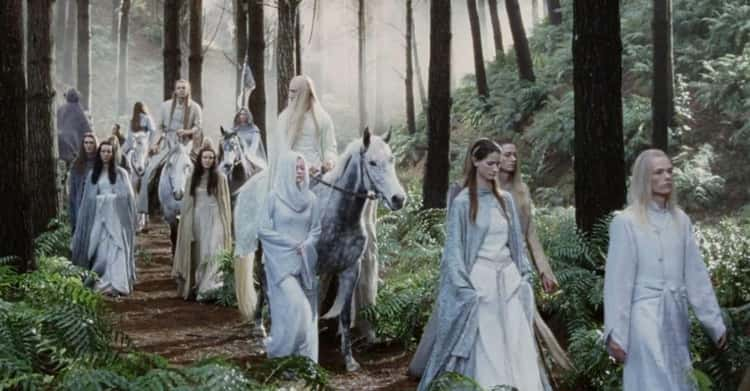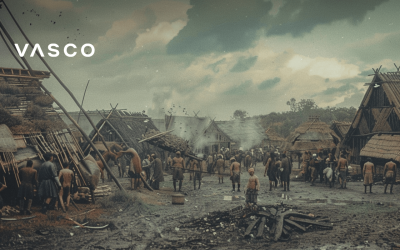The Lord of the Rings is neither a book nor a movie. It’s a cultural phenomenon and one of the biggest literary achievements of the 20th century. The influence of Middle-earth, a fictional world created by J. R. R. Tolkien, has been resonating in popular culture for almost a century now.
FAQ:
What are the words of the Black Speech?
Why does Gandalf use Black Speech?
Is Quenya the same as Elvish?
What is the difference between Tengwar and Quenya?
Does Aragorn speak Sindarin or Quenya?
Does Galadriel speak Quenya or Sindarin?
Table of Contents:
The Lord of the Rings in popular music
Both The Lord of the Rings and Hobbit-inspired various artists, from other literary authors (G. R. R. Martin, Michael Swanwick, Raymond E. Feist, and more) to TV showrunners, cartoonists, and some of the most popular rock stars. Yes, you read it right — The Lord of the Rings was present in music way before Peter Jackson’s adaptation hit the theaters in 2001.
A popular example is Ramble On — a Led Zeppelin song that appeared on the Led Zeppelin II LP in 1969. Robert Plant sings the following verse:
T’was in the darkest depths of Mordor, I met a girl so fair. But Gollum and the evil one crept up and slipped away with her.
Other examples of The Lord of the Rings in music include Black Sabbath’s The Wizard from 1970 (a song inspired by the character of Gandalf) and Rush’s song called Rivendel from 1975.
Themes from Tolkien’s high fantasy novel also made an appearance in Led Zeppelin’s The Battle for Evermore (1971), Camel’s three-part progressive rock epic from their 1974 album Mirage called Nimrodel / The Procession / The White Rider, and Blind Guardian’s Into The Storm (1998).
What is more, the Norwegian black metal band called Burzum took its name from the One Ring inscription.
Tolkien’s most famous wizard was also referenced in… one of the episodes of Friends. It is the one where Ross and Chandler are going to party with their college friend, who is also a party wizard called (surprise, surprise) Gandalf. The episode first aired in 1997.
The Lord of the Rings in other media
The Lord of the Rings influence, however, stretches far beyond popular culture. Tolkien’s work also influenced various academic disciplines. It goes without saying that this high-fantasy novel was researched by many literary scholars and cultural studies enthusiasts. J.R.R. Tolkien also gave substantive material to study linguists. And it’s the languages of Middle-earth that we will focus on in this article.
So pack your stuff, gather your companions, and prepare your weapon of choice… or just sit comfortably and grab a cup of tea. Let’s go to Middle-earth once again and learn more about the languages spoken in this compelling world of magic, warriors, and wizards.

WingNut Films. All Rights Reserved to WingNut Films and all related programs are the property of WingNut Films.
J R.R. Tolkien’s constructed languages
J R.R. Tolkien invented a great number of fictional languages. He was a philologist himself, so linguistics was something he knew a great deal about.
Many languages invented by Tolkien developed into something alive with their own history, detailed grammar, and abundant vocabulary. From Quenya and other Elvish languages to the common speech and the Black Speech of Mordor, it’s little wonder that fans from around the world learn to speak them.
So, what languages did Tolkien come up with?
There are many different Elven languages in the Lord of the Rings. There are also constructed languages that are spoken by other creatures, with humans included. In this article, however, instead of focusing on all languages in Middle Earth at once, we’ll only examine two — Quenya and the Black Speech of Mordor. The other languages, such as Sindarin, Khuzdul, and Westron, deserve a separate space. Also, we think it’ll be more than enough for one read.
What’s more, Tolkien’s linguistic knowledge of ancient Germanic languages and more helped him create a very rich world and fictional languages that are full of vocabulary and grammar rules — so there’s a lot to be written about.
In this article, you will read about the following:
- What is Quenya?
- What is Black Speech of Mordor?
- What is the history of both those languages Tolkien created?
- Who spoke them in the realm of Middle-earth?
- Are there any parallels to existing languages?
- What Tolkien language can readers actually learn to speak?

An example of a text written in the quenya language – source: Wikipedia
Quenya — the Elvish language of Valar
Outside the Middle-earth…
In the realm of Middle-earth, Quenya stands as one of the great linguistic constructs from the Elvish language family. It was featured prominently in works such as The Lord of the Rings and The Silmarillion.
Outside of Middle-earth, this Elvish language was inspired by Finnish and is one of the earliest fictional speeches invented by J.R.R. Tolkien.
Work on Quenya started as early as 1910 — it’s 27 years before the publication of The Hobbit and 44 years before the release of The Lord of the Rings. Tolkien restructured its grammar many times before it reached its final form. The vocabulary was, on the other hand, pretty stable.
As mentioned above, the Finnish language was a main source of inspiration for Quenya. Tolkien, however, also took some ideas from Greek, Welsh, and Latin, which he was studying at that time.
But what does the word Quenya actually mean if we were to translate it into English? The answer is simple — “a language”.
Let’s go back to Middle-earth…
Quenya belongs to the family of Elvish languages — it is also referred to as the High Elvish. This was an ancient tongue that, unfortunately, quickly fell out of use and became a Middle-earth equivalent of Latin. However, Quenya was also the first language ever in Tolkien’s world to be presented in a written form.
A brief history of Quenya
In the First Age, this tongue was mainly used by Calaquendi, also known as the High Elves. After Quenya had fallen out of use, Calaquendi used it as a ceremonial language and a means to express the most sublime aspects of science and poetry.
Quenya was first developed by Eldar, the elves that marched to Valinor, which is a home of Valar — divine beings who served the will of Eru Ilúvatar — an equivalent of the Christian God. Before Quenya was created, elves who started the Great March spoke Eldarin. These Elves who did not participate in the Great March spoke a language called Avarin.
Eldar then established the city of Tirion, where they developed the Quenya language. This is also why Valar adapted this speech as their own.
In the Second Age, the Quenya was spoken by the men of Númenor. It was also used by the men of Gondor and Arnor (who were the descendants of Númenóreans) to name their kings and queens. This practice was forgotten in the years of The Lord of the Rings but resumed by Aragorn, who took the name of Elessar Telcontar.

WingNut Films. All Rights Reserved to WingNut Films and all related programs are the property of WingNut Films.
Which The Lord of the Rings characters used Quenya?
Who, out of the Middle-earth characters, actually, spoke Quenya?
A good example may be Saruman bringing a storm upon the Fellowship of the Ring on Caradhras — he was casting his spell in the High Elvish language.
Here’s what Saruman was shouting in Peter Jackson’s adaptation:
Cuiva nwalca Carnirasse; nai yarvaxea rasselya! Cuiva nwalca Carnirasse; Nai yarvaxea rasselya; taltuva notto-carinnar!
which translates as:
Wake up cruel Redhorn! May your horn be bloodstained! Wake up cruel Redhorn! May your bloodstained horn fall upon enemy heads!
That’s not a coincidence that Saruman was using Quenya — he was one of the emissaries of Valar. It is strange that Gandalf’s response was in Sindarin, which is a lower form of the Quenya language. Gandalf was a Valar emissary himself.
Moreover, Frodo’s spell in Shelob’s lair was also cast in Quenya. Here’s how it goes:
Aiya Eärendil Elenion Ancalima!
which translates as:
Hail Eärendil, brightest of the Stars!
In The Fellowship of the Ring movie, Arwen casts a spell while trying to vanquish the Nine at the Bruinen — the spell is a mix of Quenya and Sindarin.
Let’s read some Quenya!
We could now examine the phonology, grammar, and vocabulary of Quenya, but it will be way more fun to actually read something in this fictional language.
Here’s the first stanza of Namárië, the longest poem written in the Quenya language that was published during Tolkien’s lifetime:
Ai! laurië lantar lassi súrinen,
yéni únótimë ve rámar aldaron!
Yéni ve lintë yuldar avánier
mi oromardi lisse-miruvóreva
Andúnë pella, Vardo tellumar
nu luini yassen tintilar i eleni
ómaryo airetári-lírinen. (J.R.R. Tolkien)
And now the English translation:
Ah! like gold fall the leaves in the wind,
long years numberless as the wings of trees!
The years have passed like swift draughts
of the sweet mead in lofty halls beyond the West,
beneath the blue vaults of Varda
wherein the stars tremble
in the song of her voice, holy and queenly.
Namárië is a reduced word of á na márië, which in turn means in English “by well”. It is a common Elvish word used to say goodbye.
How to learn Quenya?
There are over a hundred words existing in the Quenya language, based on all of the materials written by J.R.R. Tolkien. It stands as one of the richest and most well-developed languages in the realm of Middle-earth. There are unfortunately not many Quenya translators or language-learning apps which would be reliable enough in translating this Elvish language.
You can use this online translator — it works quite well, but, unfortunately, it does not provide any pronunciation tips or voice that would read the translation.
If you want to learn some Quenya, you can turn to The Elvish Linguistic Fellowship (abbreviated as E.L.F) — an international organization devoted to the study of languages constructed by J.R.R. Tolkien. They were appointed by Christopher Tolkien, the son of J.R.R Tolkien, to publish his father’s writing concerning the languages he invented.
When it comes to learning the languages of Middle Earth in general, The Elvish Linguistic Fellowship is always a good idea.
Here’s some Quenya vocabulary
Let’s look at some specific vocabulary in Quenya and its translation:
Quenya |
English |
|---|---|
| aika | broad, vast |
| aina | holy |
| ailo | lake, pool |
| haimë | habit |
| halcin | frozen |
| imbë | between |
| indo | house |
| tassë | there |
| ráva | wilderness |
| carma | weapon |

WingNut Films. All Rights Reserved to WingNut Films and all related programs are the property of WingNut Films.
The Black Speech — the vile language of Sauron’s servants
Let’s now go to the other side of the language spectrum and examine the Black Speech or the Black Speech of Mordor.
What is Black Speech?
Tolkien stated that, in the realm of Middle-earth, this tongue was created by Sauron to serve as a means of communication with all his servants.
He also wanted it to be the official language of all the lands that he dominated. What’s more, the Black Speech was meant to be an antiparallel for Khuzdul — a language of Dwarves.
The Black Speech of Mordor has 2 forms: the “pure” one spoken by Sauron, the Nazgûl (the Ringwraiths), and the Olog-hai (in other words, Trolls), and the “debased” form used by the soldiers and Orcs of Barad-dûr.
Orcs actually had their own language. It was a mix of many tongues, with the Black Speech included. At the end of the Third Age (that is, at the time of The Lord of the Rings), however, they would communicate exclusively in Westron — the common speech of Middle-earth, which is simply English.
Real-world parallels
Outside Middle-earth, the Black Speech of Mordor was compared to the Hurrian language of Northern Mesopotamia.
Tolkien also described it as an agglutinative language — a type of speech in which words are made up of distinct morphemes, with each morpheme representing a single meaning. An example of such a language is Turkish.
The One Ring inscription
Unfortunately, the Black Speech was one of Tolkien’s least developed languages. He also did not write any poems or books in it, so there is little material to examine. One text, however, is particularly useful and describes the nature of the Black Speech perfectly — the famous inscription on the One Ring:
Ash nazg durbatulûk, ash nazg gimbatul,
ash nazg thrakatulûk agh burzum-ishi krimpatul. (J.R.R Tolkien)
which translates as:
One Ring to rule them all, One Ring to find them, One Ring to bring them all and in the darkness bind them.
The above inscription was actually spoken in full in The Fellowship of the Ring movie. It happened in the extended scene during the Council of Elrond when Gandalf started to burst out the Black Speech as a warning to Boromir, who wanted to use the Ring to his advantage. Here’s a snapshot from the film:

WingNut Films. All Rights Reserved to WingNut Films and all related programs are the property of WingNut Films.
The scene corresponds with the following snippet from The Lord of the Rings book:
The change in the wizard’s voice was astounding. Suddenly it became menacing, powerful, harsh as stone. A shadow seemed to pass over the high sun, and the porch for a moment grew dark. All trembled, and the Elves stopped their ears. The Lord of the Rings, J.R.R. Tolkien, 1954.
The character of the Black Speech
Along with the scene from Peter Jackson’s movie, the above snippet from the book says quite a lot about the nature of Black Speech. It was harsh in sound, sounded utterly menacing, and gave Elves something that resembled a headache. Speaking it was, therefore, viewed as the equivalent of casting vile spells or simply saying curse words.
Tolkien wanted Black Speech to be vastly different from the Elvish languages. It was meant to be a guttural speech with a clear dominance of sounds, such as sh, gh, zg. This evil language was, however, something more than a mere collection of nasty noises.
How to speak Black Speech?
Unfortunately, there are not many reliable sources that would answer this question. However, we can draw inspiration from David Salo, a linguist who worked with Peter Jackson.
There’s one more fragment of text in the Black Speech from The Lord of the Rings universe. Salo invented the below line of text by combining the words from the Ring inscription:
Gû kîbum kelkum-ishi, burzum-ishi. Akha gûm-ishi ashi gurum.
which translates as:
No life in coldness, in darkness. Here in void, only death.
Black Speech is then definitely something more than a language created for the sole purpose of sounding evil. Take the word Nazgûl, for instance. In the Black Speech, the morphere nazg means a ring, and a morpheme gûl means a wraith.

WingNut Films. All Rights Reserved to WingNut Films and all related programs are the property of WingNut Films.
Here’s some more vocabulary of the Black Speech
Look at the table below for more examples of Black Speech:
Black Speech |
English |
|---|---|
| agh | and |
| burzum | darkness |
| durub | a ruler |
| gazat | a dwarf |
| krimp- | to bind |
| lug | a tower |
| mog | voice |
| Nazguul | a wraith |
| nuut | sky |
| prakh- | to lure |
Other popular fictional languages
There’s no doubt Tolkien is a godfather of invented languages. His attention to detail and focus on making his linguistic creations as authentic as possible inspired many creators to come. Let’s now take a look at some of the other fictional languages present in popular culture.
Klingon
One of the most popular and mature languages spoken outside the realm of Middle-earth is Klingon. It comes from the Star Trek universe and was created by Marc Okrand — an American linguist who worked with Paramount Pictures in the 1980s.
The language gained popularity so big that fans have been conducting marriage ceremonies, writing songs, and adapting real-world literature in Klingon.
Dothraki
Another popular fictional language is Dothraki from the Game of Thrones TV series. The Dothraki tribe was established in A Song of Ice and Fire by George R.R. Martin. The book already included some words in their language.
It was, however, in the HBO TV series that the language was later developed. As the tribe was nomadic and traveled a lot, the language was supposed to reflect a close relationship with horses and riding.
Na’vi
Last, but not least, let’s talk about Na’vi from Avatar. Paul Frommer, a linguist who worked with James Cameron, created an extensive vocabulary for this language so that the race Na’vi could be a fully developed concept.
Fans of the 2009 blockbuster along with Frommer quickly formed a linguistic fellowship to further develop this fictional language.
Quenya and the Black Speech of Mordor — summary
Despite the fact that The Lord of the Rings was published over half a century ago, the work of J.R.R. Tolkien is still as popular as it was years ago, maybe now even more so.
We didn’t hear Tolkien’s languages in Peter Jackson’s adaptation of the book very often, but, luckily, there are a lot of materials on the Middle-earth speeches written by the author himself.
If you’re really interested in learning more about Quenya and the Black Speech, it’s best to turn to the additional chapters of The Lord of the Rings book — they’ll give the most valuable information on Tolkien’s languages.
And if you have a passion for learning languages, but not necessarily time and motivation, be sure to check our store. With our newest standalone device, Vasco Translator V4, you have 108 languages in your pocket! Maybe someday even Quenya and the Black Speech of Mordor too…
In a nutshell:
Quenya is an Elvish language that was featured prominently in works such as The Lord of the Rings and The Silmarillion. It was first developed by Eldar, the elves that marched to Valinor, and was later adapted by Valar as their own language. In the Second Age, the Quenya was spoken by the men of Númenor. It was also used by the men of Gondor and Arnor to name their kings and queens. The Black Speech of Mordor was created by Sauron to serve as a means of communication with all his servants. It was also meant to be the official language of all the lands that he dominated. The Black Speech was compared to the Hurrian language of northern Mesopotamia.











